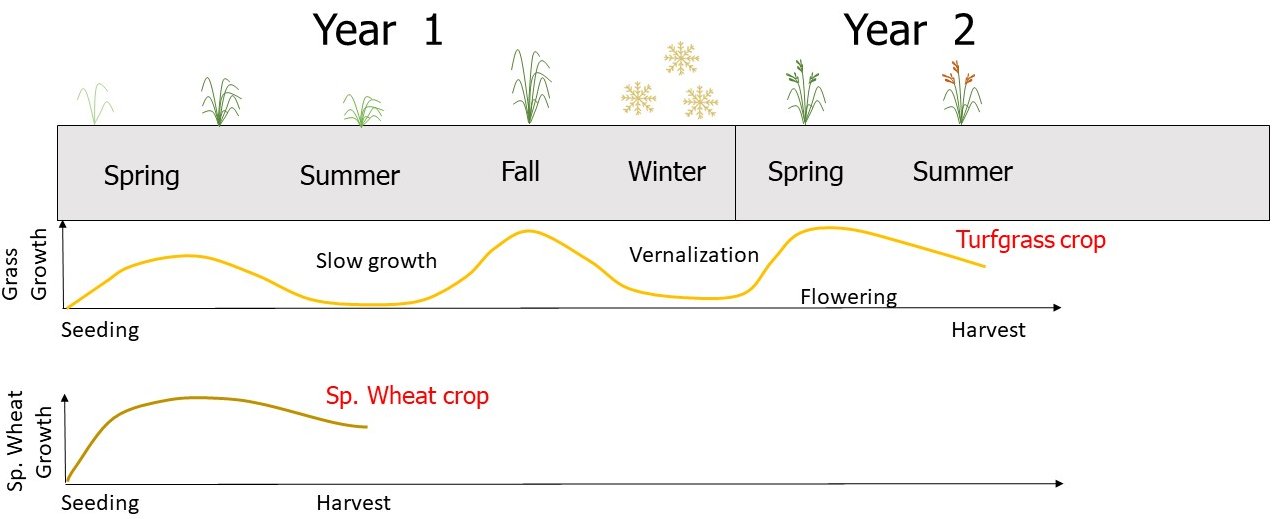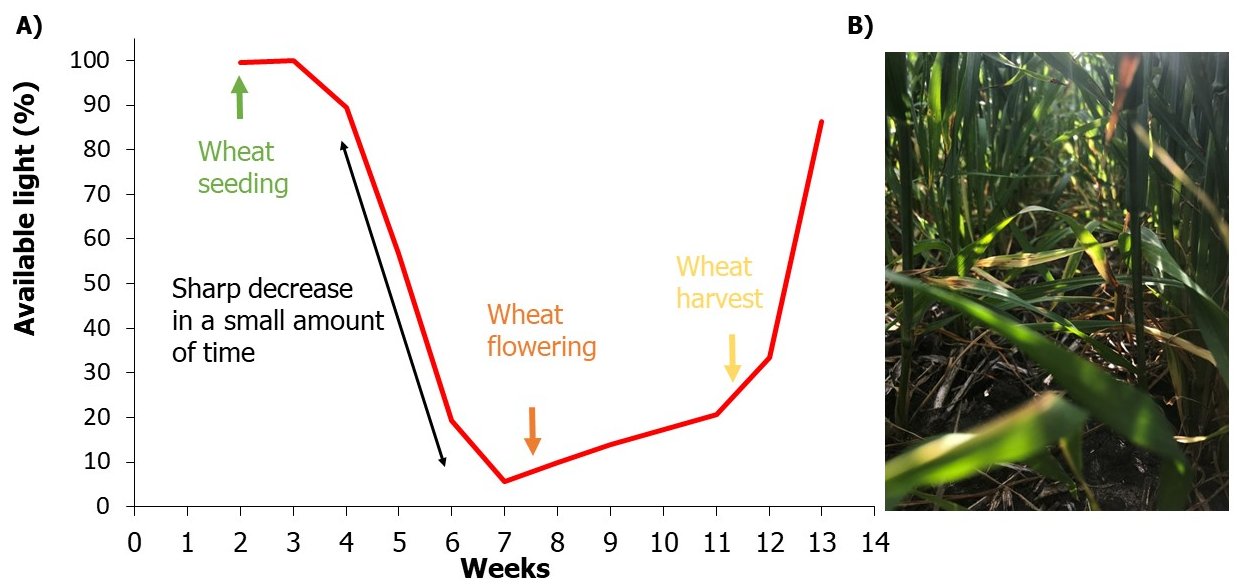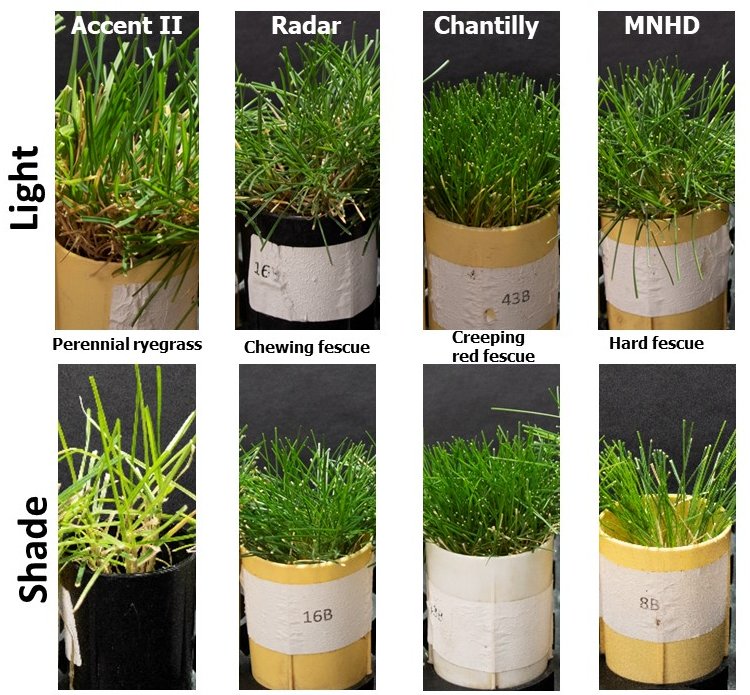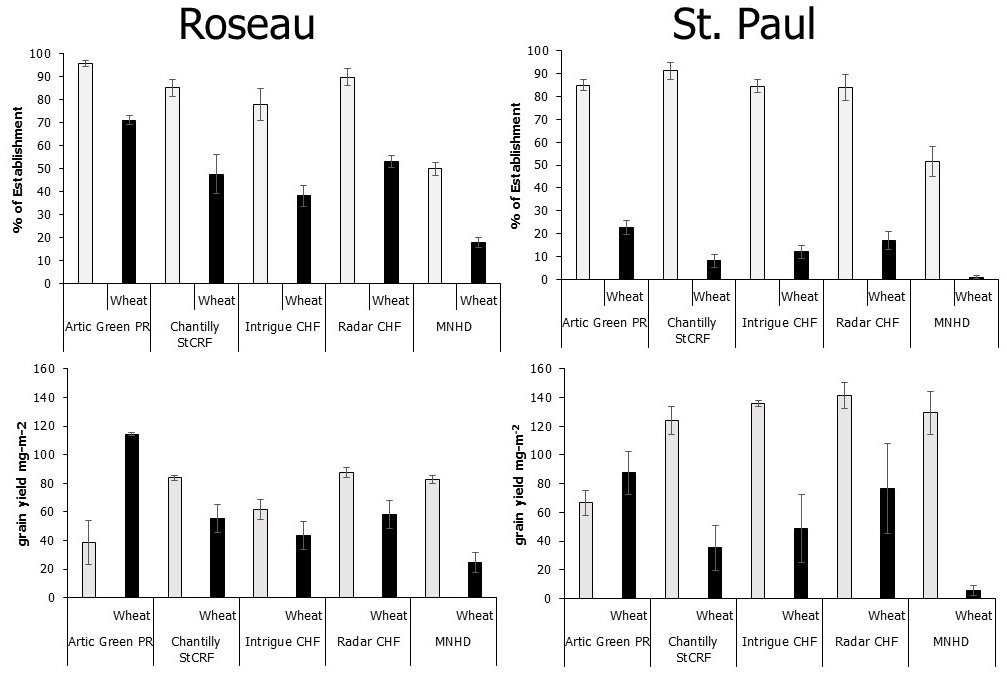By Florence Sessoms
Cool-season turfgrass seed production in Minnesota is localized in Roseau and Lake of the Woods counties in northern Minnesota. Perennial ryegrass is the primary turfgrass being produced for a total of 55,000 to 60,000 acres. Perennial ryegrass is intercropped with spring wheat to allow a better survival during the harsh winter months present up north. Also, the presence of another cash crop, such as spring wheat, allows the farmer to get some income from the field in the first year while the grass is establishing as described in Figure 1.
Intercropping is a sustainable agricultural practice during which several crops are grown together. This type of system is known to improve plant water usage and nutrient sharing while decreasing pest incidence. The success of intercropping relies on niche complementarity (meaning that the crop species use the resources in the field environment differently rather than directly competing for the same resources), especially for root and shoot architectures. Unfortunately, in our case, the growth and shoot architecture of spring wheat in addition to the 6-inch row spacing used in fields provokes a sudden and sharp decrease of light availability for the crop below the small grain (Figure 2).
Perennial ryegrass and fine fescues are two turfgrass options for crops as part of intercropping systems. Perennial ryegrass, because of its fast germination, rapid development, and strong shade avoidance responses, can establish in spring wheat shade. Fine fescue species are another group of cool season grasses that are known for their attractive aesthetics and lower input requirements (reduced mowing, fertilization and irrigation). A shade screening performed by Dr. Dominic Petrella has revealed that some fine fescue cultivars exhibit improved growth habits under foliar shade (Figure 3).
As of now, Oregon (USA) and Alberta (Canada) are the only regions of Northern America known for fine fescue seed production. In northern Minnesota, almost no fine fescue seed is currently being produced but this region possesses all the necessary equipment and infrastructure (seeding, harvesting and cleaning) for turfgrass seed production. Since few studies have evaluated these species as a companion crops, we decided to test the presence of hard fescue cv ‘MNHD’, Chewings fescue cv. ‘Radar’ and ‘Intrigue’, and strong creeping red fescue cv. ‘Chantilly’ grown alongside spring wheat. All experiments were planted using strip intercropping in St. Paul or Roseau MN in 2017 and 2018. We also use a perennial ryegrass cv. ‘Artic Green’ as a control treatment in our experiments. Fine fescue species and perennial ryegrass were planted with spring wheat and without spring wheat to study the impact of this cash crop on fine fescue establishment and seed production.
The results of our field experiments revealed that all fine fescues displayed a reduced establishment the first year followed by poor seed yield the second year (Figure 4).
Hard fescue ‘MNHD’ was the species that was impacted the most whereas Chewings fescue and strong creeping red fescue cultivars did not display as drastic of yield losses. ‘Arctic Green’ perennial ryegrass showed an increased seed yield in spring wheat because the non-wheat plots did not survive the winter conditions in Roseau and St. Paul locations. Spring wheat yield was never impacted by the presence of fine fescue species. Altogether, these experiments demonstrated that fine fescues could be intercropped with spring wheat but further research and breeding development should be performed to improve their establishment and seed production, especially hard fescue species, in intense shade conditions.
The results of these primary field experiments allowed us to obtain a research grant, "Novel Cropping Systems for Economic and Environmental Improvement in Hard Fescue Seed Production" from the Minnesota Department of Agriculture under the Agricultural Growth, Research, and Innovation (AGRI) Program, to test the effect of different cash crops (flax and winter wheat) on hard fescue seed production. We are also currently screening a large number of hard fescue accessions for improved shade tolerance. Our results will lead to the development of shade-tolerant hard fescue cultivars and improved agronomic practices for the production of hard fescue as a seed crop in northern Minnesota.



